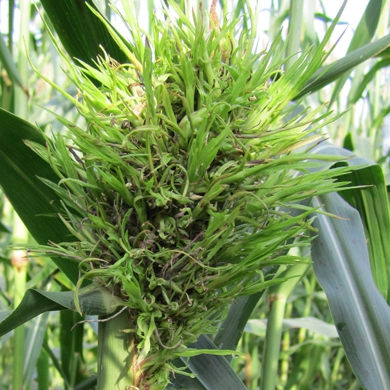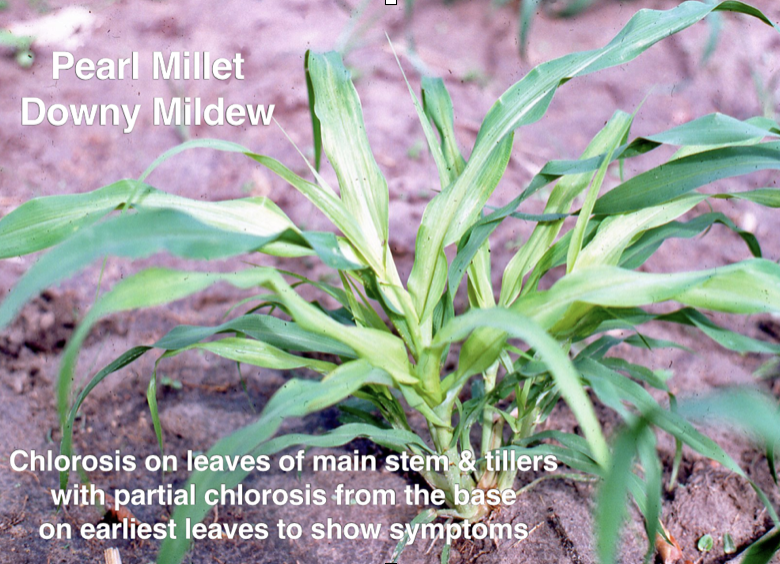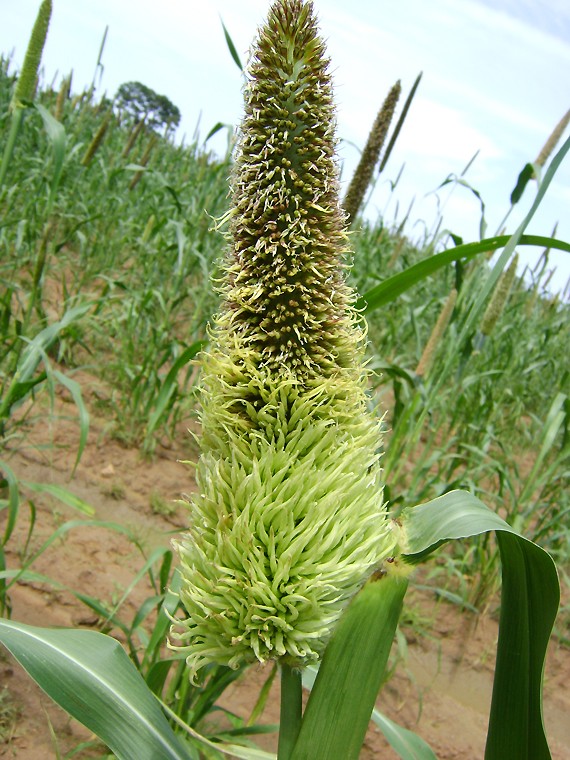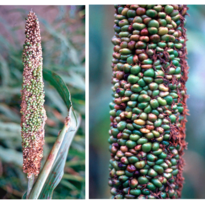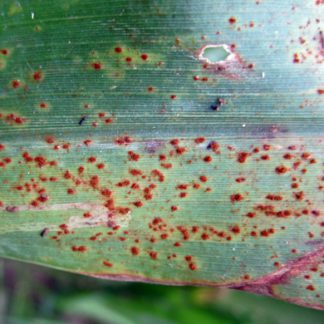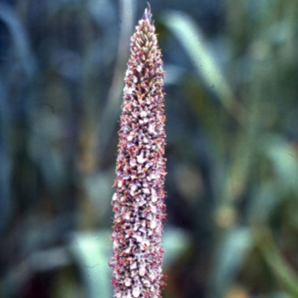Downy Mildew
Caused by: Sclerospora graminicolaProblem Category: Fungal Disease
Symptoms: The earliest symptoms are chlorosis at the base of a leaf, with subsequent leaves on the plant becoming more and more chlorotic, with the chlorosis always extending from the bases towards the tips of the leaves. The underside of chlorotic leaves develop white powdery or downy growth of sporangia and the spores that they bear. There is a distinct margin between diseased leaf tissue at base of leaf and healthy tissue towards tip. Inflorescences of infected tillers develop the characteristic green-ear symptoms where the grain is replaced by whip-like vegetative structures. Inflorescences can be partially or fully converted to green-ear, depending on the time in inflorescence development at which the infection occurred. Partial green-ear always begins at the base of the inflorescence. Plants infected at an early stage of development, before tillering begins can be killed.
Comments: Serious disease in Africa and India, occurs wherever millet is grown.
Management: The disease is systemic with the pathogen infecting the growing point of each tiller as the leaf and panicle tissues are being formed. Primary infection is from oospores which are long-lived in the soil. Secondary infection is from the spores produced by the sporangia on the undersides of infected leaves. Oospores are formed in necrotic infected plant material, which then contribute to the inoculum bank in the soil. To reduce infection rogue infected plants when found in the field; treat seeds with an appropriate systemic fungicide prior to planting and continue to spray the crop at least once every 25 days after sowing. Seed treatment Pearl millet downy mildew can be effectively controlled through the use of metalaxyl-based fungicide seed treatments. Application rates as low as 2 g a.i. per kg seed, using specially formulated seed-treatment products, can provide complete control of downy mildew even with highly susceptible hybrids. There is no value of subsequent foliar fungicide sprays following effective seed treatment. On-farm sanitation and selection In situations where resistant cultivars and seed treatments are not available, farming communities can reduce the incidence of downy mildew in pearl millet by on-farm sanitation practices and the selection of seed from robust downy mildew-free plants. Secondary spread of downy mildew within a crop is caused by the spores produced on diseased leaves, so removal of diseased plants or tillers at the first sign of disease should minimise secondary spread. Removal of diseased plants prior to inflorescence emergence, combined with selection of seed for the next season’s sowing from robust, downy mildew-free plants, should also reduce the level of susceptibility in the local cultivar gene pool developing a population of locally DM-resistant cultivars. Sanitation and selection will be more effective if done on a community basis rather than by individual farmers acting alone. The basis for effective on-farm actions is for farmers to fully understand the cause and epidemiology of the disease. Host Plant Resistance Pearl millet downy mildew is best managed by the use of resistant cultivars. Much has been learnt and done in the last 30 years to identify and utilise host plant resistance to this disease, through research done by ICRISAT in collaboration with National Agricultural Research Services (NARS) in India and other countries. In India, the existence of a strong and effective national agricultural research system together with effective public- and private-sector seed companies, has enabled the development and dissemination of a succession of cultivars and hybrids that have a high degree of resistance to downy mildew. The pathogen, however, is variable in its pathogenicity, so that cultivars or hybrids resistant to downy mildew in one region may not be resistant elsewhere. The greatest range of pathogenicity occurs in the Sahel zone of Africa, where the host and pathogen have co-evolved over a long period. Pearl millet hybrids developed for resistance to downy mildew in India have been highly susceptible when grown in the Sahel. Through the ICRISAT-NARS cooperative International Pearl Millet Downy Mildew Nursery program, sources of resistance have been identified that are effective throughout India and right across the African Sahel.
Control: spray 2 times% Cowdung+Asafoetida solution in 10 days interval. or spray 6 litres Fermented buttermilk to control the Downy mildew

